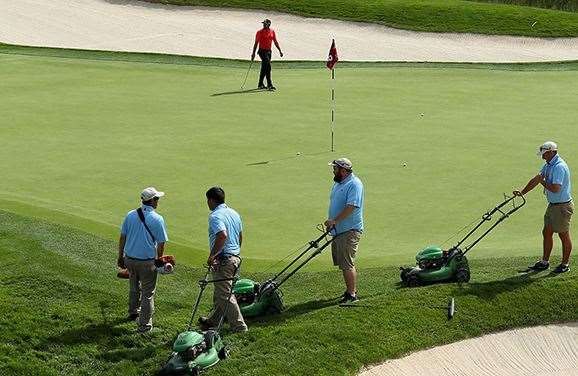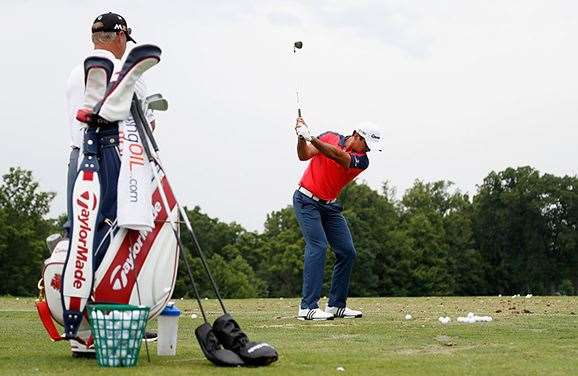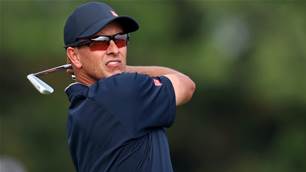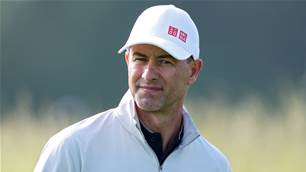The 156-man US Open field has its hands full this week as wickedly difficult Oakmont Country Club looks set to play as tough as ever.
BY JOHN HUGGAN AT OAKMONT COUNTRY CLUB
ACCORDING to World No.3 Rory McIlroy, the mood among the 156-strong field – including seven Australians – on the eve of the 116th US Open can be summed up in one word: “trepidation”.
Oakmont Country Club does that to every standard of player, though. The combination of thick rough, deep bunkers, narrow fairways and slick, sloping greens has produced, in eight previous US Opens, a low winning score of only five-under-par.
What the 7,229-yard course also produces is quality. Only two of the eight champions here are not in the World Golf Hall of Fame. And only one, local man Sam Parks in 1935, is not a winner of multiple major titles.
 Rory McIlroy says ‘trepidation’ is the word for how the players feel just hours before the US Open begins.
Rory McIlroy says ‘trepidation’ is the word for how the players feel just hours before the US Open begins.PHOTO: David Cannon/Getty Images
“This is an incredible course,” says 2006 US Open champion Geoff Ogilvy. “Normally when a venue’s mission is to be as difficult as possible it is impossible to like. That’s like the worst mentality possible for any course. But Oakmont breaks those rules. I love it.”
Such a positive outlook is also the aim of Australia’s leading player, Jason Day.
“If you’re going to have a bad attitude, you may as well not tee up,” said the reigning US PGA champion, who doubles as the world’s top-ranked golfer. “Because you probably won’t play good anyway. Not that I’m complaining. That guy is one less person I have to worry about at the end of the week. Just to go out and try to ‘play your best’ is huge. You have to come with a positive attitude regardless of the outcome.”
Adam Scott, whose US Open record before the past two years contained six missed cuts and no top-tens, was another doing a good job of looking on the bright side of US Open life.
“At least I feel like I can get myself in the hunt here after my last couple of performances,” said the former Masters champion, who was T-9 at Pinehurst in 2014 and T-4 at Chambers Bay last year.
“Thinking about it logically, you just have to hit fairways. No matter what club and strategy he uses off the tees, the guy who wins on Sunday is going to have to hit some fairways. But even that isn’t enough to guarantee success. The greens here are the most severe we will putt on all year.”
 Course preparations have received more attention this week than most.
Course preparations have received more attention this week than most.PHOTO: Andrew Redington/Getty Images
Indeed, the famously evil putting surfaces have, along with the rough that even the traditionally dark-hearted USGA conceded had to be shortened, has inevitably provoked most comment in the build-up to the year’s second major.
“A lot of the greens resemble rumpled carpets,” says Ogilvy, who is in the last year of the decade-long exemption granted to past winners. “But 100 percent of the time the pitch is from one side or the other. So it’s obvious. You can be above the hole and be okay if you are on the wide side. But if the pin is on the bottom of the slope, you are better off missing on that side. If the pin is on the high side, you need to miss on the other side. It’s not like there is one ‘best miss’ on every green no matter where the pin is. One day missing left will be best; 24 hours later missing right will be good.”
Oakmont is also ‘blessed’ with one of the most demanding finishing stretches in all of golf. Perhaps only the bleak, barren and desolate links of Carnoustie in Scotland is tougher.
 Jason Day’s rehearsal has been as meticulous as ever. He’s the $7 favourite.
Jason Day’s rehearsal has been as meticulous as ever. He’s the $7 favourite.PHOTO: Christian Petersen/Getty Images
“The last few holes are amazing,” continues Ogilvy. “And the 1st hole might be the hardest 1st hole I’ve ever seen anywhere in the world. But I really like the finish from 13 to 18. The 13th is a great par-3. The 14th is such a cool little hole where you have a chance to make birdie. The 15th is really cool too, and reminds me of holes you see on a Scottish links. I can ‘see’ hitting a running 4-iron or 5-iron onto that green. The 16th is just a great hole. The 17th is a poorly set-up but still great short par-4.
“The 18th, though, is especially good. And, as Angel Cabrera showed us back in 2007 when he won, a great drive gives a massive advantage. It’s fair to say that, while hitting the fairways doesn’t necessarily mean someone is going to do well, the guys missing fairways have no chance. The closer you get to the hole the harder Oakmont gets.”
And a winning score?
“I can see something well over par being good enough,” says Ogilvy. “The course feels very similar to 2007 when five-over won. There will be a few red numbers on the board after 36 holes but by Sunday there won’t be any. So the champion will shoot something between three- and six-over.”
Related Articles

Scott in Oakmont hunt with ‘old-man’ golf

Scott pick of Aussies after Round One at Oakmont













